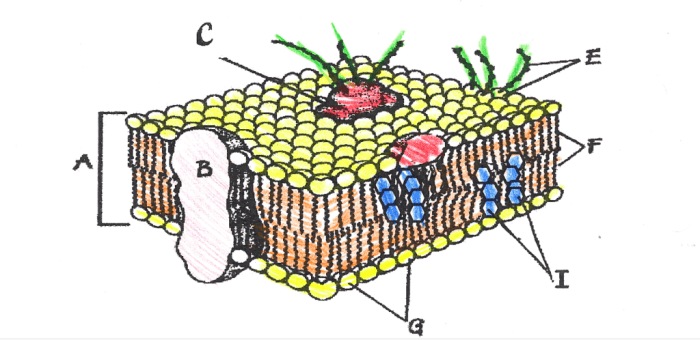Embark on an educational journey with our cell membrane coloring worksheet answers answer key, a comprehensive resource designed to illuminate the intricate structure and vital functions of the cell membrane. This interactive worksheet provides a captivating platform for students to delve into the world of cell biology, fostering a deeper understanding of this essential cellular component.
Within this comprehensive guide, we explore the fundamental structure of the cell membrane, including its phospholipid bilayer and embedded proteins, and delve into its crucial role in maintaining cellular homeostasis and facilitating communication with the external environment.
Cell Membrane Coloring Worksheet Answers
The cell membrane coloring worksheet answers provide a detailed and interactive way to understand the structure and function of the cell membrane. The completed worksheet includes labeled structures and their functions, making it a valuable resource for students and educators alike.
The following table summarizes the structures, colors, and functions of the cell membrane:
| Structure | Color | Function |
|---|---|---|
| Phospholipid bilayer | Blue | Forms the basic structure of the membrane, providing a barrier between the cell and its surroundings. |
| Cholesterol | Yellow | Regulates membrane fluidity and helps maintain the membrane’s structure. |
| Glycoproteins | Green | Participate in cell signaling and recognition, allowing the cell to interact with its environment. |
| Integral proteins | Red | Span the entire membrane, providing channels for the transport of molecules across the membrane. |
| Peripheral proteins | Purple | Attached to the surface of the membrane, they play a role in cell signaling and membrane interactions. |
Cell Membrane Structure

The cell membrane is a thin, flexible barrier that surrounds all cells. It is composed of a phospholipid bilayer, which is a double layer of phospholipids arranged tail-to-tail. The phospholipids have a hydrophilic (water-loving) head and a hydrophobic (water-hating) tail.
The hydrophilic heads face outward, interacting with the aqueous environment inside and outside the cell, while the hydrophobic tails face inward, forming a nonpolar core.Embedded within the phospholipid bilayer are various proteins. These proteins perform a variety of functions, including:
- Transporting molecules across the membrane
- Signaling between cells
- Cell recognition
The membrane is not a static structure but is constantly in flux. The phospholipids and proteins are able to move laterally within the membrane, giving the membrane its fluidity. This fluidity is essential for many cellular processes, such as cell movement and division.

Cell Membrane Functions: Cell Membrane Coloring Worksheet Answers Answer Key
The cell membrane has a number of important functions, including:
- Regulating substance transport:The cell membrane controls the movement of molecules into and out of the cell. This is essential for maintaining the cell’s homeostasis, or internal balance.
- Cell signaling:The cell membrane is involved in cell signaling, allowing cells to communicate with each other. This is essential for coordinating cellular activities and responding to changes in the environment.
- Cell recognition:The cell membrane helps cells recognize each other. This is essential for immune function, tissue development, and other cellular interactions.
The cell membrane is a dynamic structure that plays a vital role in cell function. It is constantly interacting with the external environment, regulating the flow of substances into and out of the cell, and mediating cell signaling and recognition.
Cell Membrane Coloring Activity
Coloring worksheets can be a valuable tool for teaching cell membrane structure and function. They provide a hands-on, interactive way for students to learn about the different components of the cell membrane and their functions.Coloring activities can also enhance student engagement and understanding.
By actively participating in the learning process, students are more likely to retain information and develop a deeper understanding of the subject matter.Here are some suggestions for incorporating the cell membrane coloring worksheet into lesson plans:
- Use the worksheet as a pre-assessment to gauge students’ prior knowledge of the cell membrane.
- Use the worksheet as a review activity after teaching about the cell membrane.
- Use the worksheet as a homework assignment to reinforce students’ understanding of the cell membrane.
FAQ Compilation
What are the primary functions of the cell membrane?
The cell membrane serves as a selective barrier, regulating the transport of substances into and out of the cell. It also plays a crucial role in cell signaling, enabling communication between cells, and cell recognition, allowing cells to identify and interact with specific molecules.
How does the cell membrane maintain homeostasis within the cell?
The cell membrane actively regulates the movement of ions and molecules across its lipid bilayer, maintaining the cell’s internal environment and protecting it from external fluctuations.
What are the educational benefits of using coloring worksheets to teach cell membrane structure and function?
Coloring worksheets provide a visual and engaging way to learn about the cell membrane. By coloring different structures and labeling their functions, students can actively engage with the material, improving their comprehension and retention.